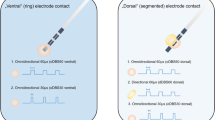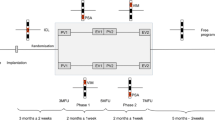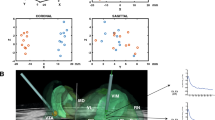Abstract
In patients with essential tremor (ET) already treated with chronic deep brain stimulation (DBS) of the nucleus ventralis intermedius (VIM) we investigated whether optimization of stimulation parameters could improve clinical tremor suppression, and whether this putative effect could be sustained over time. Twenty-three ET patients with VIM-DBS participated in the prospective study. All electrode contacts were tested systematically and stimulation parameters were optimized over the course of 2 days. Clinical tremor rating scale (TRS) was videotaped before, directly after the optimization and at a 10 weeks follow-up and evaluated blindly and independently by two clinicians. For stimulation effect optimization we increased the number of active contacts whereas the total charge applied to the tissue was kept constant. TRS hemi-body scores decreased significantly after optimization. At the 10 weeks follow-up, however, the improvement had faded and was no longer significant. The activities of daily living (ADL) remained significantly improved. Systematic optimization of VIM-DBS parameters in ET patients leads to a short term improvement which habituates over time. Our results provide further evidence for a tolerance effect in chronic VIM stimulation thereby suggesting that frequently alternating stimulation protocols should be tested in future studies of ET patients treated with VIM-DBS.


Similar content being viewed by others
References
Benabid AL, Pollak P, Gao D, Hoffmann D, Limousin P, Gay E, Payen I, Benazzouz A (1996) Chronic electrical stimulation of the ventralis intermedius nucleus of the thalamus as a treatment of movement disorders. J Neurosurg 84(2):203–214. doi:10.3171/jns.1996.84.2.0203
Limousin P, Speelman JD, Gielen F, Janssens M (1999) Multicentre european study of thalamic stimulation in parkinsonian and essential tremor. J Neurol Neurosurg Psychiatry 66(3):289–296
Schuurman PR, Bosch DA, Bossuyt PM, Bonsel GJ, van Someren EJ, de Bie RM, Merkus MP, Speelman JD (2000) A comparison of continuous thalamic stimulation and thalamotomy for suppression of severe tremor. N Engl J Med 342(7):461–468
Hariz MI, Shamsgovara P, Johansson F, Hariz G, Fodstad H (1999) Tolerance and tremor rebound following long-term chronic thalamic stimulation for parkinsonian and essential tremor. Stereotact Funct Neurosurg 72(2–4):208–218. doi:10.1159/000029728
Koller WC, Lyons KE, Wilkinson SB, Troster AI, Pahwa R (2001) Long-term safety and efficacy of unilateral deep brain stimulation of the thalamus in essential tremor. Mov Disord 16(3):464–468
Garcia Ruiz P, de Igneson MJ, Lopez Ferro O, Martin C, Magarinos Ascone C (2001) Deep brain stimulation holidays in essential tremor. J Neurol 248(8):725–726
Kronenbuerger M, Fromm C, Block F, Coenen VA, Rohde I, Rohde V, Noth J (2006) On-demand deep brain stimulation for essential tremor: a report on four cases. Mov Disord 21(3):401–405. doi:10.1002/mds.20714
Fahn (1988) Clinical rating scale for tremor. In: Tolosa JJaE (ed) Parkinson’s disease and movement disorders. Urban & Schwarzenberg, Baltimore, pp 225–234
Rehncrona S, Johnels B, Widner H, Tornqvist AL, Hariz M, Sydow O (2003) Long-term efficacy of thalamic deep brain stimulation for tremor: double-blind assessments. Mov Disord 18(2):163–170. doi:10.1002/mds.10309
Randolph JJ (2008) Online kappa calculator. Retrieved March 30, 2010, from www.justus.randolph.name/kappa
Schnitzler A, Munks C, Butz M, Timmermann L, Gross J (2009) Synchronized brain network associated with essential tremor as revealed by magnetoencephalography. Mov Disord 24(11):1629–1635. doi:10.1002/mds.22633
Moro E, Poon YY, Lozano AM, Saint-Cyr JA, Lang AE (2006) Subthalamic nucleus stimulation: improvements in outcome with reprogramming. Arch Neurol 63(9):1266–1272. doi:10.1001/archneur.63.9.noc60069
Acknowledgments
We thank the patients for study participation and cooperation. This study was supported by a grant of the German Research Foundation (DFG), Clinical Research Group 219 (KFO 219) to L.T. and G.R.F (TI 319/2-1, FI 773/8-1 and SCHU 1439/3-1).
Conflict of interest
None.
Author information
Authors and Affiliations
Corresponding authors
Rights and permissions
About this article
Cite this article
Barbe, M.T., Liebhart, L., Runge, M. et al. Deep brain stimulation in the nucleus ventralis intermedius in patients with essential tremor: habituation of tremor suppression. J Neurol 258, 434–439 (2011). https://doi.org/10.1007/s00415-010-5773-3
Received:
Revised:
Accepted:
Published:
Issue Date:
DOI: https://doi.org/10.1007/s00415-010-5773-3




